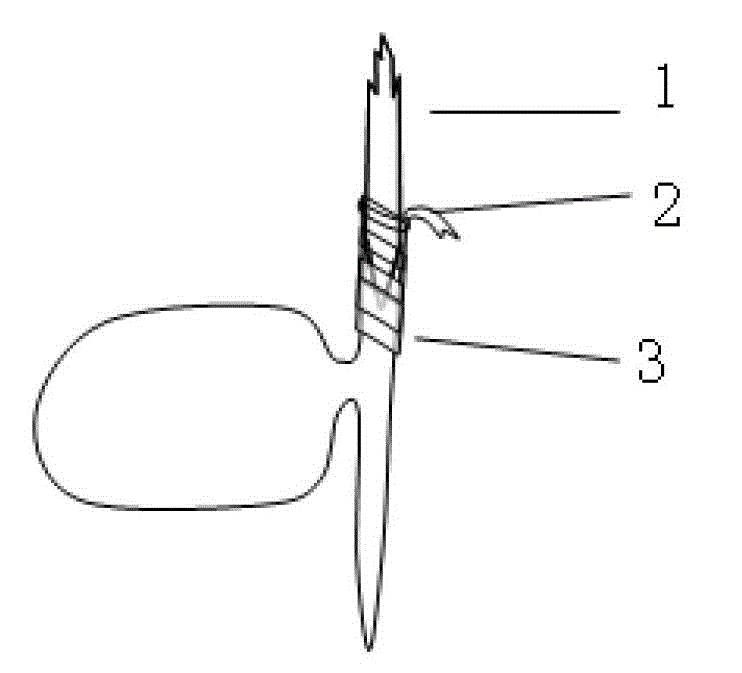Cuttage-grafting seedling raising method for rubber trees
A technology for rubber trees and seedlings, which is applied to the field of rubber tree plugging and seedling raising method, can solve the problems of complicated operation, failure of budding, large workload of erasing rootstock buds, etc., and achieves the effects of simple grafting operation, shortening seedling raising time, and simplifying the grafting operation process.
- Summary
- Abstract
- Description
- Claims
- Application Information
AI Technical Summary
Problems solved by technology
Method used
Image
Examples
Embodiment 1
[0016] Select 800 fresh and plump rubber tree seeds harvested in August and sow them on the sand bed to accelerate germination and cultivate them for 15 days. Select 400 strong seedlings with a height of about 4cm, pull them out together with the seeds, wash them with clean water, and use a budding knife to put embryos on the seedlings. The top of the shaft 3 is repeatedly cross-cut to let the latex flow out until no latex flows out, and put it aside for future use.
[0017] 20 days before bud grafting, select the robust bud strips of rubber trees to be grafted; cut off the terminal buds of the bud strips to promote the sprouting of new shoots from the leaf buds; The small stem section of bud or side bud is used as scion 1, and is for subsequent use.
[0018] Make another cut at the incision at the top of the epicotyl 3 of the seedling, cut off the length of the end to be no more than 0.3 cm, then longitudinally cut a "one"-shaped opening along the widest section of the top of...
Embodiment 2
[0021] Select 500 fresh and plump rubber tree seeds harvested in September and sow them on the sand bed to accelerate germination and cultivate them for 18 days. Select 200 strong seedlings with a height of about 5 cm, pull them out together with the seeds, wash them with clean water, and use a budding knife to put embryos on the seedlings. The top of the shaft 3 is repeatedly cross-cut to let the latex flow out until no latex flows out, and put it aside for future use.
[0022] 25 days before bud grafting, select the robust bud strips of the rubber tree species to be grafted; cut off the terminal buds of the bud strips to promote the sprouting of new shoots from the leaf buds; The small stem section of bud or side bud is used as scion 1, and is for subsequent use.
[0023] Make another cut at the incision at the top of the epicotyl 3 of the seedling, cut off the length of the end not greater than 0.3cm, then longitudinally cut the "one"-shaped opening along the widest section...
Embodiment 3
[0026] Select 300 fresh and plump rubber tree seeds harvested in October and sow them on the sand bed to accelerate germination and cultivate them for 20 days. Select 100 robust seedlings with a height of about 6 cm, pull them out together with the seeds, wash them with clean water, and use a bud knife to germinate the seedlings. The top of the axis 3 is repeatedly cross-cut to let the latex flow out until no latex flows out, and put it aside for future use.
[0027] 28 days before bud grafting, select the robust bud strips of rubber trees to be grafted; cut off the terminal buds of the bud strips to promote the sprouting of new shoots from the leaf buds; select new shoots with a stem thickness equivalent to the stem of the seedlings, and cut out 5 cm long, with terminal buds Or the small stem section of lateral buds is used as scion 1 for subsequent use.
[0028] Make another cut at the incision at the top of the epicotyl 3 of the seedling, cut off the length of the end to be...
PUM
 Login to View More
Login to View More Abstract
Description
Claims
Application Information
 Login to View More
Login to View More - R&D
- Intellectual Property
- Life Sciences
- Materials
- Tech Scout
- Unparalleled Data Quality
- Higher Quality Content
- 60% Fewer Hallucinations
Browse by: Latest US Patents, China's latest patents, Technical Efficacy Thesaurus, Application Domain, Technology Topic, Popular Technical Reports.
© 2025 PatSnap. All rights reserved.Legal|Privacy policy|Modern Slavery Act Transparency Statement|Sitemap|About US| Contact US: help@patsnap.com


